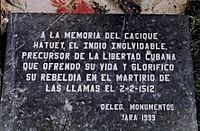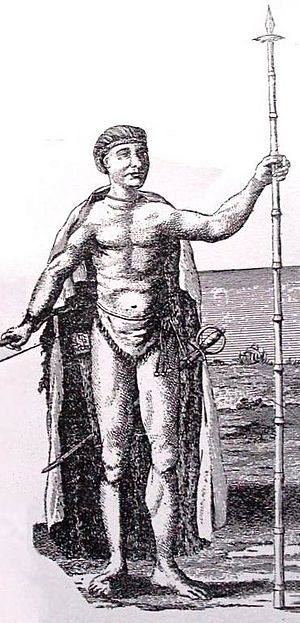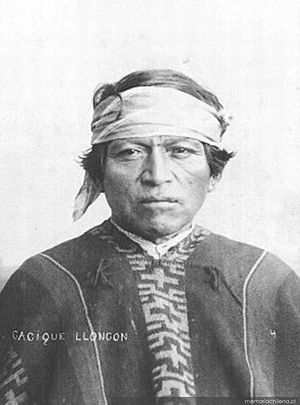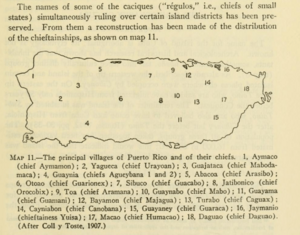Cacique facts for kids
A cacique (pronounced ka-SEE-kay) was a tribal chief or leader of the Taíno people. The Taíno were the native people living in the Bahamas, the Greater Antilles, and the northern Lesser Antilles when Europeans first arrived. The word cacique comes from the Taíno word kasike. The Spanish adopted this word.
At first, the Spanish translated cacique as "king" or "prince." Later, during the colonial period, Spanish explorers and rulers used the word more generally. They used it for almost any leader of the native groups they met in the Western Hemisphere. In some Spanish and Portuguese-speaking countries today, cacique can also mean a powerful political boss. This system of rule is called caciquismo.
Contents
Caciques in Spanish Colonial Times
The Taíno word kasike comes from kassiquan, which means "to keep house." In Taíno culture, the role of kasike was usually passed down through families. Sometimes, leaders were chosen by the people. The Taíno were mostly a peaceful people. So, a kasike's importance came from the size of their family or group, not from their fighting skills.
Taíno kasikes had special benefits. They lived in a larger, rectangular hut in the middle of the village. Other villagers lived in round huts around the edges. They also had special spots to watch areytos (ceremonial dances) and ball games. Most importantly, the kasike's word was law. They used this power to manage a complex government that touched all parts of their community's life.

The Spanish used the term cacique for local leaders of almost any native group in Spanish America. Some Caribbean caciques did not fight the Spanish at first. They became go-betweens, helping their communities deal with the Spanish. However, this cooperation often did not last. Many early caciques eventually rebelled, and they were often killed in battle or executed. Two famous early caciques from this time are Hatuey from what is now Cuba and Enriquillo from the island of Hispaniola. Both are now national heroes in their countries.
The Spanish had more success working with leaders from the highly organized native civilizations in Central Mexico. These Central Mexican caciques became more effective and loyal helpers in the new colonial system. The Spanish often recognized native nobles as a type of European nobility. A cacique's status, and that of their family, was boosted by being allowed to use the Spanish noble titles don and doña.
As go-betweens, caciques were often the first to bring European goods and ideas into their communities. They built Spanish-style houses, filled them with Spanish furniture, and wore European clothes. They also started Spanish businesses, like raising sheep and cattle. Some even owned enslaved people to work these businesses. Caciques also gained new privileges they didn't have before. These included the right to carry swords or guns and to ride horses or mules. Some caciques had special family lands called cacicazgos.
By the late colonial period in central Mexico, the term cacique had lost its meaning of a ruling family. Their status could still add to a family's importance, but it no longer meant they had major power. After Mexico became independent in 1821, the special privileges of colonial-era caciques were finally removed.
In the Andean region, people preferred the local term kuraka instead of cacique. After conquering the Inca Empire, the Spanish allowed the kurakas to keep their noble titles and local power. This was true as long as they promised loyalty to the Spanish king.
In 1781, the Tupac Amaru rebellion was led by a kuraka named Túpac Amaru II. He claimed to be a descendant of the Inca royal family. When countries in the region gained independence in 1825, noble titles were abolished. However, the power of the kurakas was already fading after the Great Rebellion.
Caciquismo and Caudillismo
The term caciquismo ("boss rule") refers to a political system where local political bosses, the caciques, hold a lot of power. After Mexico gained independence, the term cacique still meant "native" leaders. But it also started to mean any "local" or "regional" leader.
Some experts see a difference between caudillos (strong political leaders) and their rule, called caudillismo, and caciques and caciquismo. One writer, Carlos Octavio Bunge, thought caciquismo came from chaos and then became a more peaceful form of "civilized caciquismo." An example he gave was Mexico's Porfirio Díaz (who ruled from 1876-1911).
In Spain, caciquismo was seen in the late 1800s and early 1900s. Some believe that Galicia in northwest Spain suffered for centuries because of caciquismo and favoritism.
In the Philippines, the term cacique democracy was created by Benedict Anderson. It describes a political system where local leaders are very strong, almost like warlords. The Philippines was a Spanish colony until 1898. Then, the United States took control. The U.S. brought many changes to modernize the government and trade. However, the local Filipino elites, who were better educated and connected, often used these changes to make their own positions stronger.
There is no single agreement among experts about where caciquismo came from. Some suggest that the terms cacique and caudillo have been used so broadly that they might have lost some of their clear meaning.
Taíno Caciques
- Agüeybaná (The Great Sun)
- Agüeybaná II (The Brave)
- Anacaona
- Arasibo
- Brizuela
- Caguax
- Comerío
- Enriquillo
- Guacanagarix
- Guamá
- Guarionex
- Habaguanex
- Hatuey
- Hayuya
- Huarea
- Jumacao
- Loquillo
- Orocobix
- Urayoán
Notable Native Caciques of the Americas
- Agüeybaná I of the Taino of Puerto Rico
- Agüeybaná II of the Taino of Puerto Rico
- Aquiminzaque of the Muisca of Chunsa
- Araribóia of the Temininós of Espírito Santo
- Arasibo of the Taino of Puerto Rico
- Atlácatl of the Pipil of El Salvador
- Carlos of the Calusa
- Catacora of Acora and Puno
- Caguax of the Taino of Puerto Rico
- Chacao of Venezuela
- Correque of the Huetar of Costa Rica
- Cunhambebe of the Tupinambás of São Paulo
- El Guarco of the Huetar of Costa Rica
- El Quibían of the Ngäbe of Panama
- Felipe Camarão of the Potiguara
- Garabito of the Huetar of Costa Rica
- Gonzalo Mazatzin Moctezuma of Mexico
- Guaicaipuro of the Teques and Caracas
- Guamá of the Taino of Cuba
- Guaicaipuro of Venezuela
- Guarionex of the Taino of Hispaniola
- Hatuey of the Taino of Hispaniola
- Idacansás of the Muisca of Colombia
- Inacayal of the Tehuelche
- Jumacao of the Taino of Puerto Rico
- Juan de Lebu of the Moluche of Chile
- Lempira of the Lenca of Honduras
- Macuilmiquitzi of the Mangue of Costa Rica
- María of the Tehuelche of Patagonia
- Orocobix of the Taino of Puerto Rico
- Urracá of the Ngäbe of Panama
- Saguamanchica of the Muisca of Muyquytá
- Saturiwa of the Timucua
- Sepé Tiaraju of the Guarani Missions
- Tamanaco of the Mariches and Quiriquires
- Tibiriçá of the Tupiniquims of São Paulo
- Urriparacoxi of central Florida
- Diriangén of the Chorotega of Nicaragua
See also
 In Spanish: Cacique para niños
In Spanish: Cacique para niños
- Caciques in Puerto Rico
- Caudillo
- Gregorio de San Juan
- Kalku
- Lonko
- Machi
- Gregor MacGregor, he claimed to be cacique of Poyais, a fictional Central American country
- European colonization of the Americas
- Guaicaipuro





